Citroen C4 RHD 2014 2.G Owner's Manual
Manufacturer: CITROEN, Model Year: 2014, Model line: C4 RHD, Model: Citroen C4 RHD 2014 2.GPages: 328
Page 151 of 328
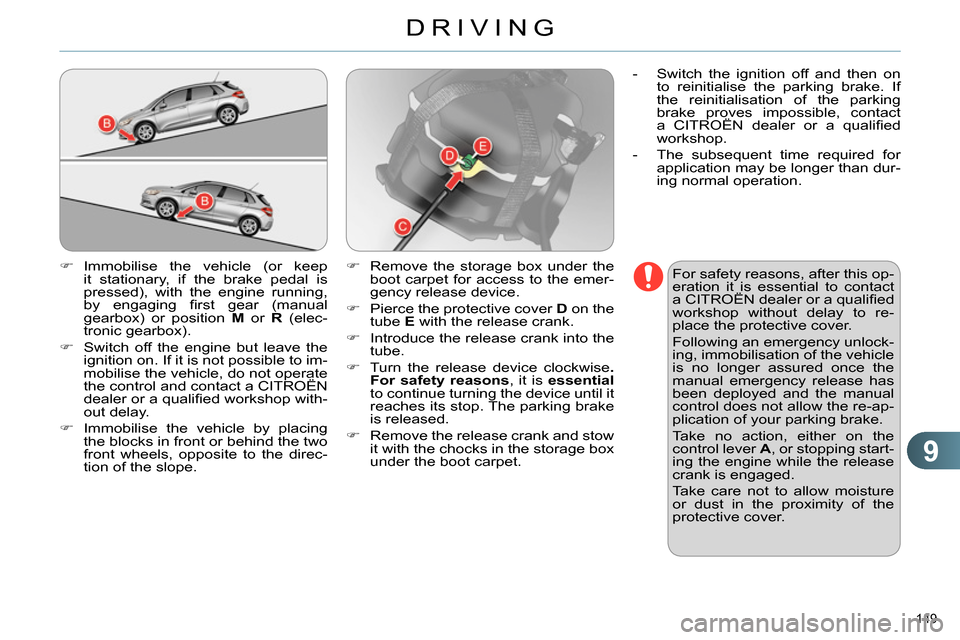
9
DRIVING
149
Immobilise the vehicle (or keep
it stationary, if the brake pedal is
pressed), with the engine running,
by engaging fi rst gear (manual
gearbox) or position M
or R
(elec-
tronic gearbox).
Switch off the engine but leave the
ignition on. If it is not possible to im-
mobilise the vehicle, do not operate
the control and contact a CITROËN
dealer or a qualifi ed workshop with-
out delay.
Immobilise the vehicle by placing
the blocks in front or behind the two
front wheels, opposite to the direc-
tion of the slope.
For safety reasons, after this op-
eration it is essential to contact
a CITROËN dealer or a qualifi ed
workshop without delay to re-
place the protective cover.
Following an emergency unlock-
ing, immobilisation of the vehicle
is no longer assured once the
manual emergency release has
been deployed and the manual
control does not allow the re-ap-
plication of your parking brake.
Take no action, either on the
control lever A
, or stopping start-
ing the engine while the release
crank is engaged.
Take care not to allow moisture
or dust in the proximity of the
protective cover.
Remove the storage box under the
boot carpet for access to the emer-
gency release device.
Pierce the protective cover D
on the
tube E
with the release crank.
Introduce the release crank into the
tube.
Turn the release device clockwise .
For safety reasons
, it is essential
to continue turning the device until it
reaches its stop. The parking brake
is released.
Remove the release crank and stow
it with the chocks in the storage box
under the boot carpet.
- Switch the ignition off and then on
to reinitialise the parking brake. If
the reinitialisation of the parking
brake proves impossible, contact
a CITROËN dealer or a qualifi ed
workshop.
- The subsequent time required for
application may be longer than dur-
ing normal operation.
Page 152 of 328
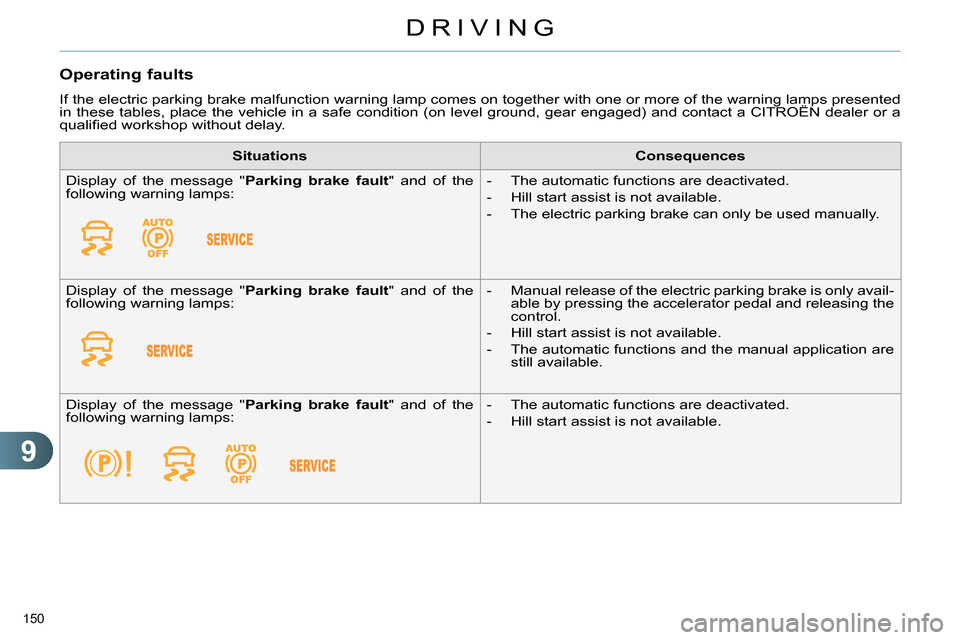
9
DRIVING
150
Operating faults
If the electric parking brake malfunction warning lamp comes on together with one or more of the warning lamps presented
in these tables, place the vehicle in a safe condition (on level ground, gear engaged) and contact a CITROËN dealer or a
qualifi ed workshop without delay.
Situations
Consequences
Display of the message " Parking brake fault
" and of the
following warning lamps:
- The automatic functions are deactivated.
- Hill start assist is not available.
- The electric parking brake can only be used manually.
Display of the message " Parking brake fault
" and of the
following warning lamps:
- Manual release of the electric parking brake is only avail-
able by pressing the accelerator pedal and releasing the
control.
- Hill start assist is not available.
- The automatic functions and the manual application are
still available.
Display of the message " Parking brake fault
" and of the
following warning lamps:
- The automatic functions are deactivated.
- Hill start assist is not available.
Page 153 of 328
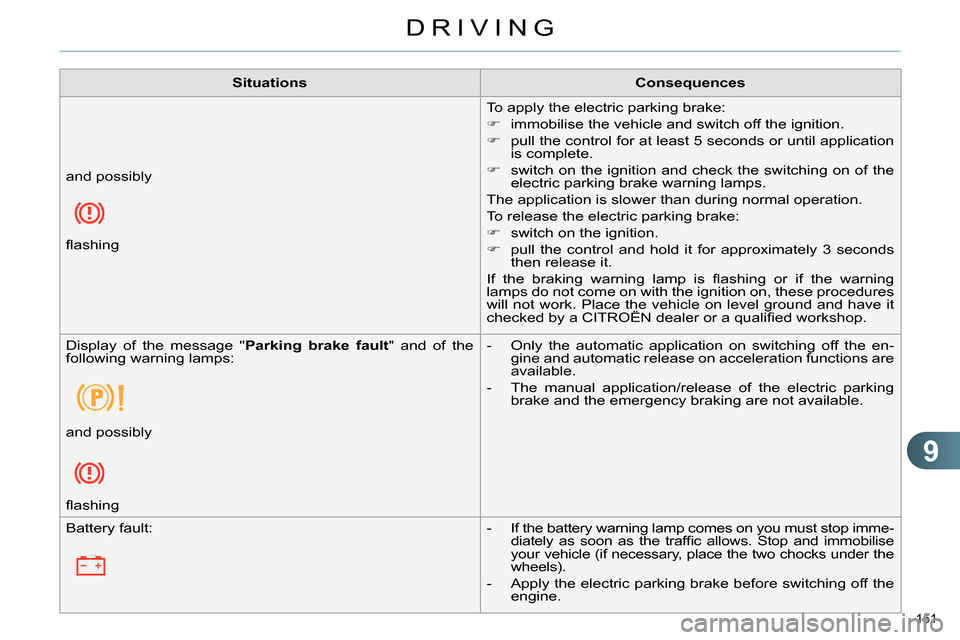
9
DRIVING
151
Situations
Consequences
To apply the electric parking brake:
immobilise the vehicle and switch off the ignition.
pull the control for at least 5 seconds or until application
is complete.
switch on the ignition and check the switching on of the
electric parking brake warning lamps.
The application is slower than during normal operation.
To release the electric parking brake:
switch on the ignition.
pull the control and hold it for approximately 3 seconds
then release it.
If the braking warning lamp is fl ashing or if the warning
lamps do not come on with the ignition on, these procedures
will not work. Place the vehicle on level ground and have it
checked by a CITROËN dealer or a qualifi ed workshop. and possibly
fl ashing
Display of the message " Parking brake fault
" and of the
following warning lamps:
- Only the automatic application on switching off the en-
gine and automatic release on acceleration functions are
available.
- The manual application/release of the electric parking
brake and the emergency braking are not available.
and possibly
fl ashing
Battery fault:
- If the battery warning lamp comes on you must stop imme-
diately as soon as the traffi c allows. Stop and immobilise
your vehicle (if necessary, place the two chocks under the
wheels).
- Apply the electric parking brake before switching off the
engine.
Page 154 of 328
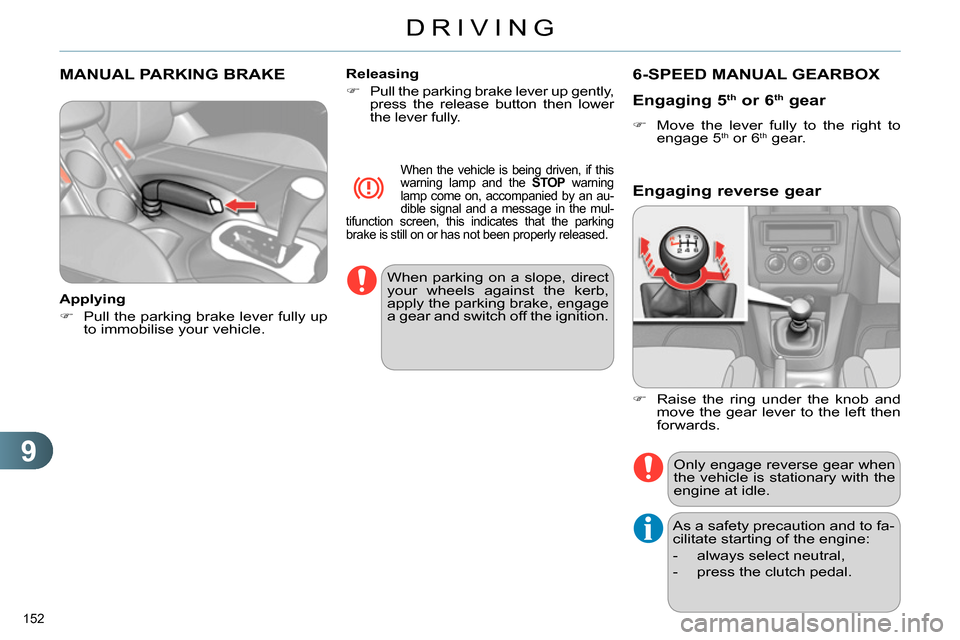
9
DRIVING
152
MANUAL PARKING BRAKE
Applying
Pull the parking brake lever fully up
to immobilise your vehicle.
Releasing
Pull the parking brake lever up gently,
press the release button then lower
the lever fully.
When the vehicle is being driven, if this
warning lamp and the STOP
warning
lamp come on, accompanied by an au-
dible signal and a message in the mul-
tifunction screen, this indicates that the parking
brake is still on or has not been properly released.
When parking on a slope, direct
your wheels against the kerb,
apply the parking brake, engage
a gear and switch off the ignition.
6-SPEED MANUAL GEARBOX
Engaging 5
th
or 6 th
gear
Move the lever fully to the right to
engage 5 th or 6 th
gear.
Only engage reverse gear when
the vehicle is stationary with the
engine at idle.
As a safety precaution and to fa-
cilitate starting of the engine:
- always select neutral,
- press the clutch pedal.
Engaging reverse gear
Raise the ring under the knob and
move the gear lever to the left then
forwards.
Page 155 of 328
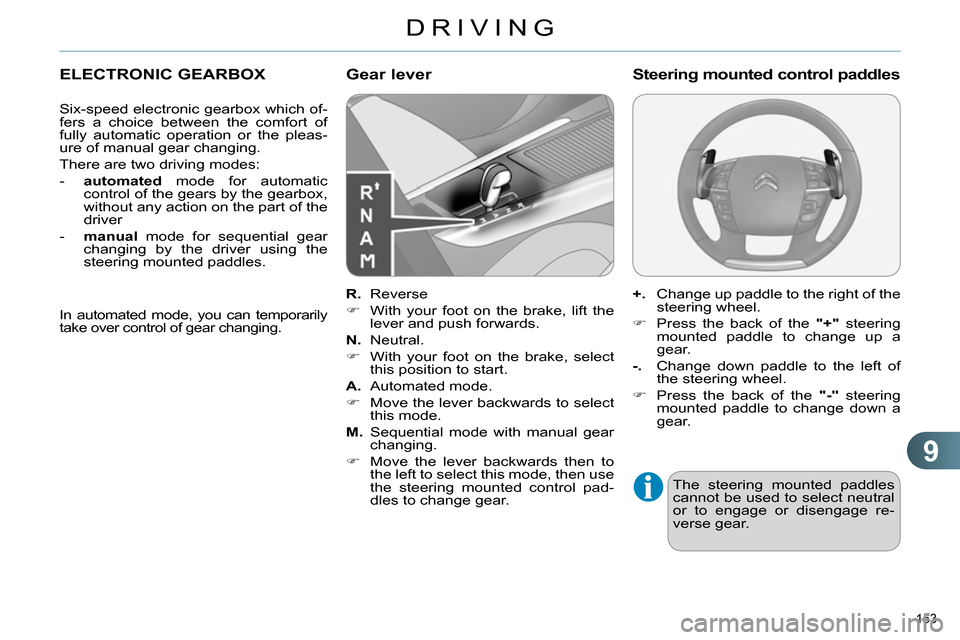
9
DRIVING
153
ELECTRONIC GEARBOX
Six-speed electronic gearbox which of-
fers a choice between the comfort of
fully automatic operation or the pleas-
ure of manual gear changing.
There are two driving modes:
- automated
mode for automatic
control of the gears by the gearbox,
without any action on the part of the
driver
- manual
mode for sequential gear
changing by the driver using the
steering mounted paddles.
R.
Reverse
With your foot on the brake, lift the
lever and push forwards.
N.
Neutral.
With your foot on the brake, select
this position to start.
A.
Automated mode.
Move the lever backwards to select
this mode.
M.
Sequential mode with manual gear
changing.
Move the lever backwards then to
the left to select this mode, then use
the steering mounted control pad-
dles to change gear.
Gear lever
+.
Change up paddle to the right of the
steering wheel.
Press the back of the "+"
steering
mounted paddle to change up a
gear.
-.
Change down paddle to the left of
the steering wheel.
Press the back of the "-"
steering
mounted paddle to change down a
gear.
Steering mounted control paddles
The steering mounted paddles
cannot be used to select neutral
or to engage or disengage re-
verse gear.
In automated mode, you can temporarily
take over control of gear changing.
Page 156 of 328
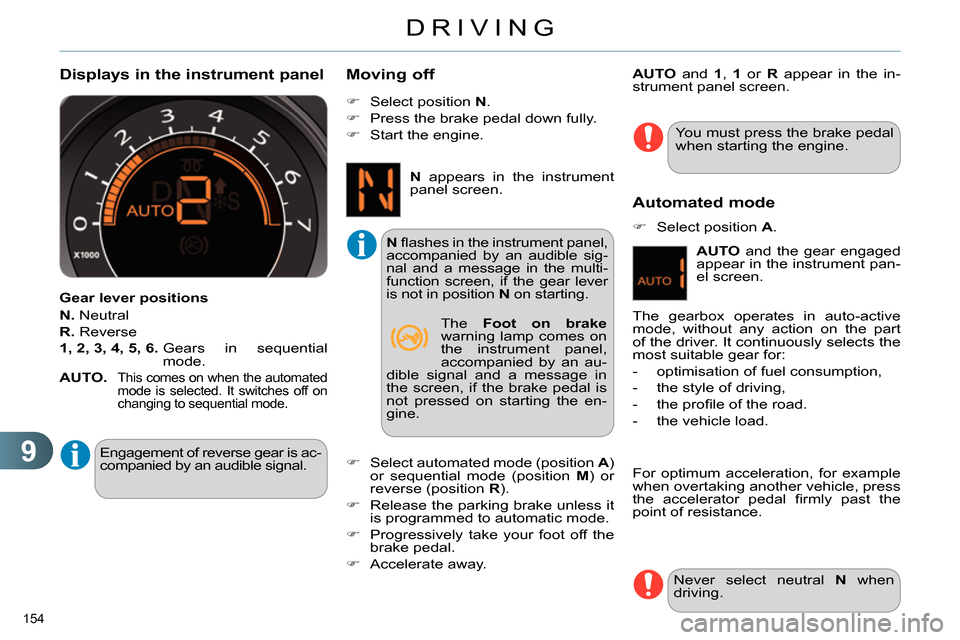
9
DRIVING
154
Displays in the instrument panel
Gear lever positions
N.
Neutral
R.
Reverse
1, 2, 3, 4, 5, 6.
Gears in sequential
mode.
AUTO.
This comes on when the automated
mode is selected. It switches off on
changing to sequential mode.
You must press the brake pedal
when starting the engine.
Select position N
.
Press the brake pedal down fully.
Start the engine.
Moving off
Select automated mode (position A
)
or sequential mode (position M
) or
reverse (position R
).
Release the parking brake unless it
is programmed to automatic mode.
Progressively take your foot off the
brake pedal.
Accelerate away.
Automated mode
Select position A
.
For optimum acceleration, for example
when overtaking another vehicle, press
the accelerator pedal fi rmly past the
point of resistance.
Engagement of reverse gear is ac-
companied by an audible signal.
N
fl ashes in the instrument panel,
accompanied by an audible sig-
nal and a message in the multi-
function screen, if the gear lever
is not in position N
on starting.
AUTO
and 1
, 1
or R
appear in the in-
strument panel screen.
The gearbox operates in auto-active
mode, without any action on the part
of the driver. It continuously selects the
most suitable gear for:
- optimisation of fuel consumption,
- the style of driving,
- the profi le of the road.
- the vehicle load.
N
appears in the instrument
panel screen.
The Foot on brake
warning lamp comes on
the instrument panel,
accompanied by an au-
dible signal and a message in
the screen, if the brake pedal is
not pressed on starting the en-
gine.
Never select neutral N
when
driving.
AUTO
and the gear engaged
appear in the instrument pan-
el screen.
Page 157 of 328
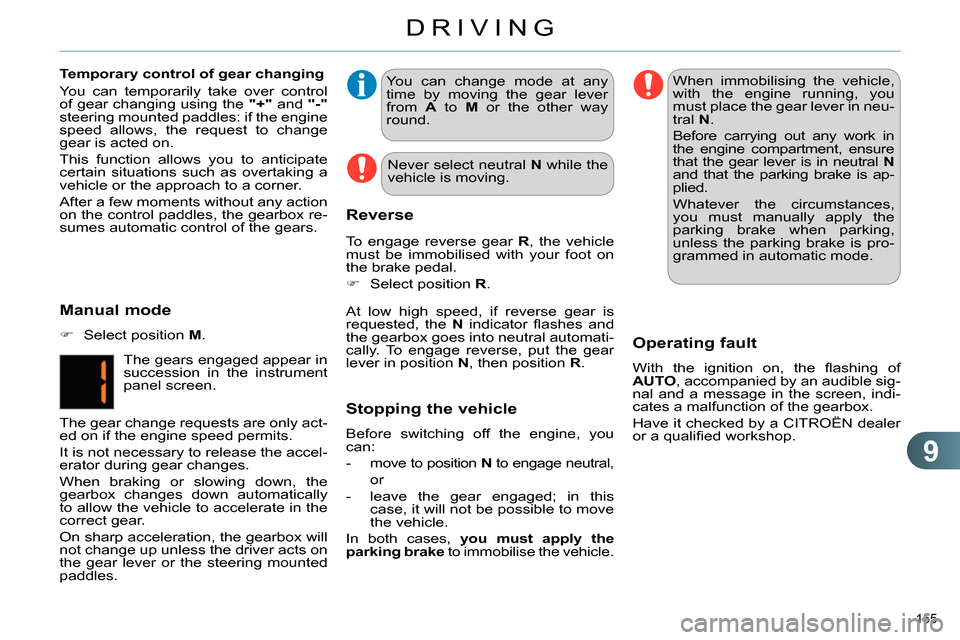
9
DRIVING
155
You can change mode at any
time by moving the gear lever
from A
to M
or the other way
round.
At low high speed, if reverse gear is
requested, the N
indicator fl ashes and
the gearbox goes into neutral automati-
cally. To engage reverse, put the gear
lever in position N
, then position R
.
When immobilising the vehicle,
with the engine running, you
must place the gear lever in neu-
tral N
.
Before carrying out any work in
the engine compartment, ensure
that the gear lever is in neutral N
and that the parking brake is ap-
plied.
Whatever the circumstances,
you must manually apply the
parking brake when parking,
unless the parking brake is pro-
grammed in automatic mode.
Reverse
To engage reverse gear R
, the vehicle
must be immobilised with your foot on
the brake pedal.
Select position R
.
Operating fault
With the ignition on, the fl ashing of
AUTO
, accompanied by an audible sig-
nal and a message in the screen, indi-
cates a malfunction of the gearbox.
Have it checked by a CITROËN dealer
or a qualifi ed workshop.
Manual mode
Select position M
.
The gears engaged appear in
succession in the instrument
panel screen.
The gear change requests are only act-
ed on if the engine speed permits.
It is not necessary to release the accel-
erator during gear changes.
When braking or slowing down, the
gearbox changes down automatically
to allow the vehicle to accelerate in the
correct gear.
On sharp acceleration, the gearbox will
not change up unless the driver acts on
the gear lever or the steering mounted
paddles.
Temporary control of gear changing
You can temporarily take over control
of gear changing using the "+"
and "-"
steering mounted paddles: if the engine
speed allows, the request to change
gear is acted on.
This function allows you to anticipate
certain situations such as overtaking a
vehicle or the approach to a corner.
After a few moments without any action
on the control paddles, the gearbox re-
sumes automatic control of the gears.
Never select neutral N
while the
vehicle is moving.
Stopping the vehicle
Before switching off the engine, you
can:
- move to position N
to engage neutral,
or
- leave the gear engaged; in this
case, it will not be possible to move
the vehicle.
In both cases, you must apply the
parking brake
to immobilise the vehicle.
Page 158 of 328

9
DRIVING
156
AUTOMATIC GEARBOX
Six speed automatic gearbox which of-
fers a choice between the comfort of
fully automatic operation, enhanced by
sport and snow programmes, or manu-
al gear changing.
Four driving modes are offered:
- automatic
operation for electronic
management of the gears by the
gearbox,
- sport
programme for a more dy-
namic style of driving,
- snow
programme to improve driving
when traction is poor,
- manual
operation for sequential
changing of the gears by the driver.
Gear selection gate
1.
Gear lever.
2.
Button "S"
(sport)
.
3.
Button "
" (snow)
.
P.
Park.
- Immobilisation of the vehicle, park-
ing brake on or off.
- Starting the engine.
R.
Reverse.
- Reversing manoeuvres, vehicle sta-
tionary, engine at idle.
N.
Neutral.
- Immobilisation of the vehicle, parking
brake on.
- Starting the engine.
D.
Automatic operation.
M +/-
. Manual operation with sequential
changing of the six gears.
Press forwards to change up
through the gears.
or
Press rearwards to change down
through the gears.
Gear lever
When you move the lever in the gate
to select a position, the corresponding
indicator is displayed in the instrument
panel.
P.
Park
R.
Reverse
N.
Neutral
D.
Drive (Automatic driving)
S.
Sport
programme
. Snow
programme
1 to 6.
Gear engaged during manual
operation
-.
Invalid value during manual operation
Displays in the instrument panel
Page 159 of 328
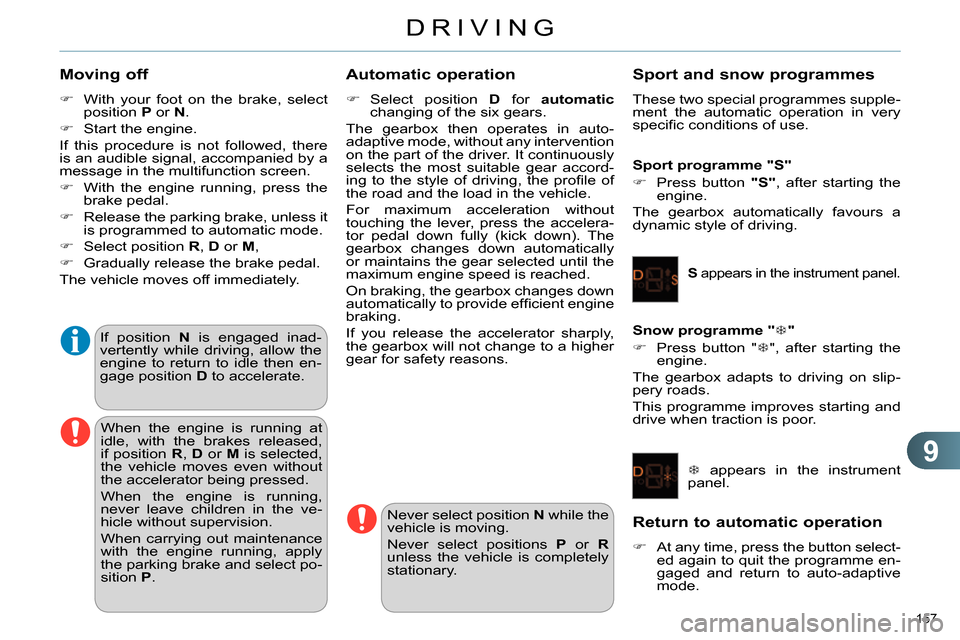
9
DRIVING
157
Moving off
With your foot on the brake, select
position P
or N
.
Start the engine.
If this procedure is not followed, there
is an audible signal, accompanied by a
message in the multifunction screen.
With the engine running, press the
brake pedal.
Release the parking brake, unless it
is programmed to automatic mode.
Select position R
, D
or M
,
Gradually release the brake pedal.
The vehicle moves off immediately.
If position N
is engaged inad-
vertently while driving, allow the
engine to return to idle then en-
gage position D
to accelerate.
When the engine is running at
idle, with the brakes released,
if position R
, D
or M
is selected,
the vehicle moves even without
the accelerator being pressed.
When the engine is running,
never leave children in the ve-
hicle without supervision.
When carrying out maintenance
with the engine running, apply
the parking brake and select po-
sition P
.
Automatic operation
Select position D
for automatic
changing of the six gears.
The gearbox then operates in auto-
adaptive mode, without any intervention
on the part of the driver. It continuously
selects the most suitable gear accord-
ing to the style of driving, the profi le of
the road and the load in the vehicle.
For maximum acceleration without
touching the lever, press the accelera-
tor pedal down fully (kick down). The
gearbox changes down automatically
or maintains the gear selected until the
maximum engine speed is reached.
On braking, the gearbox changes down
automatically to provide effi cient engine
braking.
If you release the accelerator sharply,
the gearbox will not change to a higher
gear for safety reasons.
Never select position N
while the
vehicle is moving.
Never select positions P
or R
unless the vehicle is completely
stationary.
Sport and snow programmes
These two special programmes supple-
ment the automatic operation in very
specifi c conditions of use.
Sport programme "S"
Press button "S"
, after starting the
engine.
The gearbox automatically favours a
dynamic style of driving.
S
appears in the instrument panel.
Snow programme "
"
Press button "
", after starting the
engine.
The gearbox adapts to driving on slip-
pery roads.
This programme improves starting and
drive when traction is poor.
appears in the instrument
panel.
Return to automatic operation
At any time, press the button select-
ed again to quit the programme en-
gaged and return to auto-adaptive
mode.
Page 160 of 328
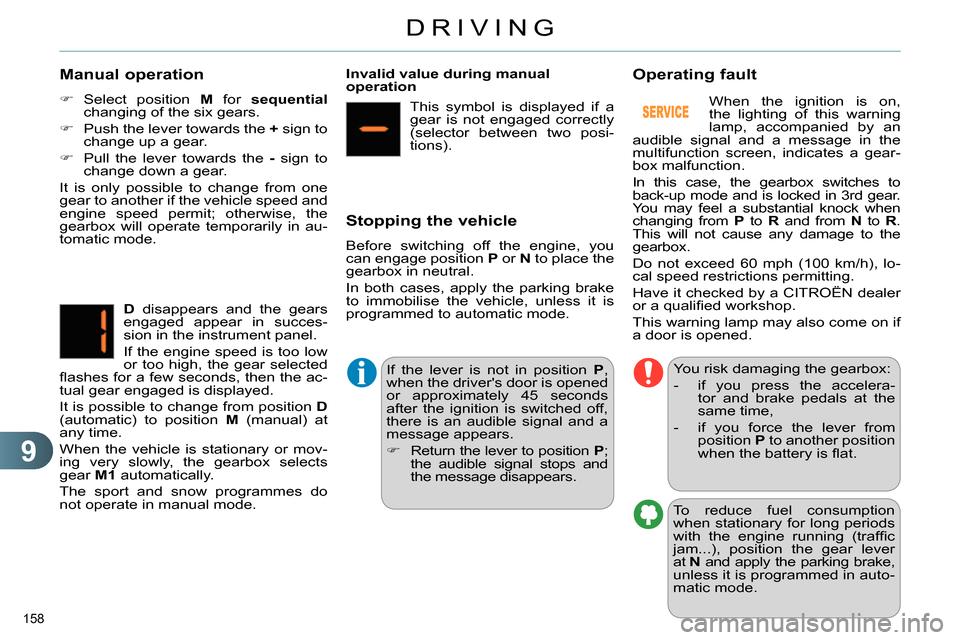
9
DRIVING
158
Manual operation
Select position M
for sequential
changing of the six gears.
Push the lever towards the +
sign to
change up a gear.
Pull the lever towards the -
sign to
change down a gear.
It is only possible to change from one
gear to another if the vehicle speed and
engine speed permit; otherwise, the
gearbox will operate temporarily in au-
tomatic mode.
D
disappears and the gears
engaged appear in succes-
sion in the instrument panel.
If the engine speed is too low
or too high, the gear selected
fl ashes for a few seconds, then the ac-
tual gear engaged is displayed.
It is possible to change from position D
(automatic) to position M
(manual) at
any time.
When the vehicle is stationary or mov-
ing very slowly, the gearbox selects
gear M1
automatically.
The sport and snow programmes do
not operate in manual mode.
Invalid value during manual
operation
This symbol is displayed if a
gear is not engaged correctly
(selector between two posi-
tions).
Stopping the vehicle
Before switching off the engine, you
can engage position P
or N
to place the
gearbox in neutral.
In both cases, apply the parking brake
to immobilise the vehicle, unless it is
programmed to automatic mode.
If the lever is not in position P
,
when the driver's door is opened
or approximately 45 seconds
after the ignition is switched off,
there is an audible signal and a
message appears.
Return the lever to position P
;
the audible signal stops and
the message disappears.
You risk damaging the gearbox:
- if you press the accelera-
tor and brake pedals at the
same time,
- if you force the lever from
position P
to another position
when the battery is fl at. When the ignition is on,
the lighting of this warning
lamp, accompanied by an
audible signal and a message in the
multifunction screen, indicates a gear-
box malfunction.
In this case, the gearbox switches to
back-up mode and is locked in 3rd gear.
You may feel a substantial knock when
changing from P
to R
and from N
to R
.
This will not cause any damage to the
gearbox.
Do not exceed 60 mph (100 km/h), lo-
cal speed restrictions permitting.
Have it checked by a CITROËN dealer
or a qualifi ed workshop.
This warning lamp may also come on if
a door is opened.
Operating fault
To reduce fuel consumption
when stationary for long periods
with the engine running (traffi c
jam...), position the gear lever
at N
and apply the parking brake,
unless it is programmed in auto-
matic mode.